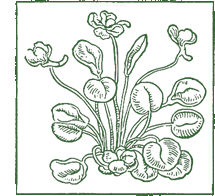This flower was cultivated throughout antiquity by Persians, Athenians (who associated it with Aphrodite, Orpheus and Zeus), Arabs, Romans and Spanish. It was highly prized for its color and scent, and was used in dyes and perfumes. In medieval England, violets were a symbol of modesty and constancy:
 “Violet is for faithfulness Which in me shall abide...”
“Violet is for faithfulness Which in me shall abide...”
— from a popular songbook of 1566
Shakespeare associated violets with life cut short because they flower in the spring, but “wither all” before mid-summer. Early in the play, Laertes warns Ophelia of the transience of Hamlet’s affections for her (I, iii, 7–10):
“A Violet in the youth of primy nature,
Forward, not permanent; sweet, not lasting.
The perfume and suppliance of a minute;
No more.”
With her reference to violets, Ophelia anticipates her own untimely death.